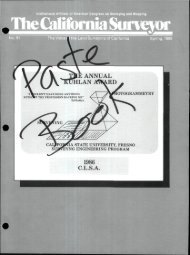The California Surveyor - CLSA
The California Surveyor - CLSA
The California Surveyor - CLSA
Create successful ePaper yourself
Turn your PDF publications into a flip-book with our unique Google optimized e-Paper software.
vector is drawn toward areas of<br />
greater mass and therefore the geoid<br />
bends upward in these areas. Conversely,<br />
in areas with a deficiency of<br />
mass, the geoid bends downward.<br />
In <strong>California</strong>, geoidal undulations<br />
vary by several meters:<br />
Location Geoid Height (from OSU 91A)<br />
Near Yuma, AZ<br />
Santa Barbara<br />
Lone Pine<br />
Sacramento<br />
Crescent City<br />
-33.2 m<br />
-36.8 m<br />
-26.0 m<br />
-29.8 m<br />
-25.2 m<br />
-109 ft.<br />
-121 ft.<br />
-85 ft.<br />
-98 ft.<br />
-83 ft.<br />
Undulations of 50 ppm are not<br />
uncommon in the mountainous<br />
areas of the state. Globally, the geoid<br />
height varies +/-100 meters. One of<br />
the greatest challenges remaining for<br />
geodetic science is the precise mapping<br />
of the detailed undulations of<br />
the geoid.<br />
Vertical Datum<br />
Several possibilities exist, and have<br />
been used, to define a vertical datum.<br />
A tide gauge can locate mean<br />
sea level at a particular location by<br />
observations of sea level variations<br />
over an extended period of time<br />
(typically a 19 year cycle). As already<br />
discussed, mean sea level at one<br />
location is not necessarily on the<br />
same equipotential surface as mean<br />
sea level at an other location. <strong>The</strong><br />
NGVD 29 resolved this conflict by<br />
constraining the general adjustment<br />
at 26 tide gauges. Five sites in<br />
Canada, and 21 sites in the U.S.A.<br />
were held fixed in the general adjustment<br />
of 106,724 km. (66,315 mi.)<br />
of leveling. This means that NGVD<br />
29 is neither an equipotential surface<br />
nor an accurate approximation of the<br />
geoid.<br />
In the definition of NAVD 88, the<br />
limitation of a datum surface distorted<br />
to fit sea surface topography<br />
was considered incompatible with<br />
modern surveying technology. Space<br />
based geodetic surveying techniques<br />
(e.g. GPS, SLR, VLBI) are capable of<br />
providing extremely accurate geodetic<br />
height differences in terms of<br />
height above a reference ellipsoid.<br />
<strong>The</strong> prospect of these methods in<br />
conjunction with a precise geoid is<br />
too valuable to sacrifice to a distorted<br />
datum.<br />
<strong>The</strong> NAVD 88 was defined by a<br />
single least squares adjustment of<br />
1,300,000 km. (808,000 mi.) of leveling<br />
data in the U.S.A., Canada, and<br />
Mexico. This adjustment was completed<br />
in June of 1991 and included<br />
80,000 km. (49,700 mi.) of new leveling<br />
in the U.S.A., VLBI height differences,<br />
and a total of 709,000 marks.<br />
<strong>The</strong> Coast and Geodetic Survey (formerly<br />
the National Geodetic Survey)<br />
selected the new International Great<br />
Lakes Datum of 1985 (IGLD 85) local<br />
mean sea level height at station<br />
POINT-AU-PERE (Father Point) /<br />
RIMOUSKI as the minimum-constraint<br />
datum point for NAVD 88.<br />
POINT-AU-PERE/RIMOUSKI is located<br />
at the mouth of the St.<br />
Lawrence River in Quebec, Canada.<br />
It was selected to minimize the impact<br />
of NAVD 88 on the national<br />
mapping programs of the U.S.A. and<br />
Canada, and upon international<br />
treaties regarding shipping in the<br />
Great Lakes.<br />
Orthometiric Heights<br />
Examination of the elevation change<br />
from NGVD 29 to NAVD 88 in<br />
<strong>California</strong> reveals differences of 60<br />
cm. (1.97 ft.) to 120 cm. (3.94 ft.) (see<br />
Figure V. But the change is not of a<br />
uniform slope or curve. Why is it<br />
that the elevation change is so<br />
irregular? Well, some of the irregularity<br />
is attributable to the distortion<br />
in NGVD 29 from sea surface topography,<br />
and some is from the errors<br />
which exist in the NGVD 29 leveling<br />
and adjustments, but the majority of<br />
the contouring is the result of refinement<br />
of a geodetic term known as<br />
the orthometric height correction.<br />
As was previously stated, no two<br />
equipotential surfaces are parallel.<br />
Any line of differential levels naturally<br />
passes through an infinite number<br />
of equipotential surfaces since it<br />
is run on the ground at varying distances<br />
from the geoid. <strong>The</strong><br />
orthometric height correction attempts<br />
to compensate for the<br />
non-parallism of the equipotential<br />
surfaces on which the leveling<br />
observations were made. This correction<br />
requires precise gravity<br />
measurements to be processed simultaneously<br />
with the leveling data.<br />
<strong>The</strong> NAVD 88 adjustment utilized<br />
improved gravity measurements to<br />
accurately model the orthometric<br />
height correction. <strong>The</strong> greatest magnitude<br />
for the correction occurs in<br />
the mountainous regions where<br />
deflection of the vertical is<br />
greatest and the NGVD 29 models<br />
were most deficient.<br />
<strong>California</strong> NGVD 29 to NAVD 88 Figure 1<br />
OREGON<br />
NAVD 88 Leveling<br />
NGVD 29 to NAVD 88 (CM)<br />
CONTINUED ON PACE 18<br />
Fall 1992 <strong>The</strong> <strong>California</strong> <strong>Surveyor</strong> 17

















